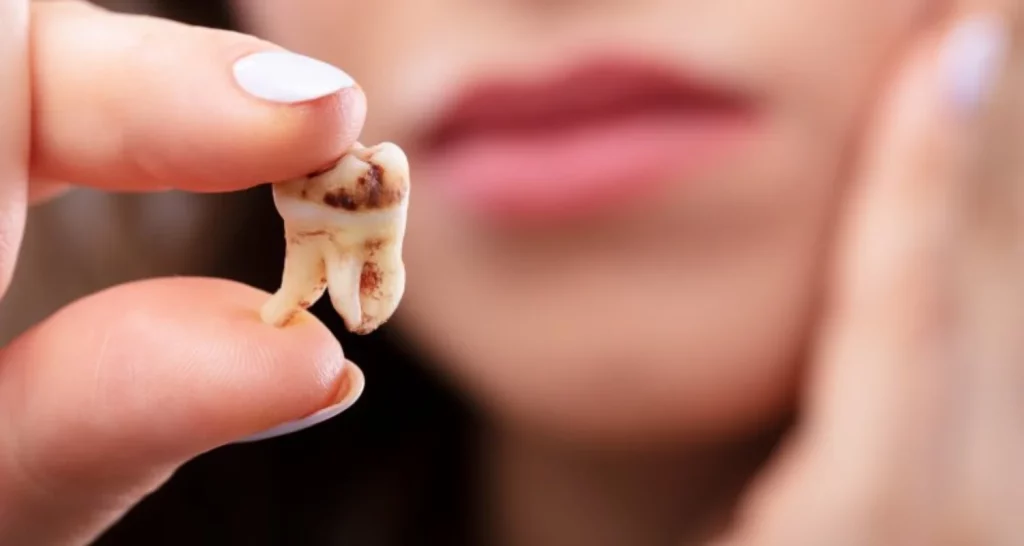Last Updated on: 4th December 2024, 12:22 pm
Teeth are made of hard and soft tissues. The hard tissues are enamel, dentin, and cement; they are found in the outermost part that protects the soft tissue: the dental pulp. When the dental pulp is severely attacked, it dies; then we say that the tooth is dead. In this article, we will talk about how to deal with a dead tooth.
What is Dental Pulp?

The dental pulp is a set of small arteries, veins, and nerves found in the innermost part of the tooth. It is contained in a space known as the pulp chamber and runs along each of the roots of the teeth, through spaces known as root canals. Dental pulp has several important functions:
-
- Formative: The pulp is responsible for dentinogenesis or tooth formation.
- Nutritious: Through blood vessels, the dental pulp supplies oxygen and nutrients to the cells of the tooth.
- Sensitive: The pulp perceives temperature and pressure stimuli and sends pain signals when the tooth is suffering from damage.
- Defensive: Inside the dental pulp are small lymphatic vessels and other structures that defend the tooth from infection; when damaged, they can even induce hard tissue repair.
Why do Teeth Die?
Teeth die from two main causes:
1. Caries
Caries are the formation of holes in the teeth, caused mainly by poor hygiene. When these pits expose the dental pulp to the oral environment and temperature changes, it becomes inflamed. The dental pulp is enclosed in a space with hard walls (composed of dentin), so when it becomes inflamed, blood flow can be cut off and necrosis can occur.
2. Trauma
When teeth receive severe blows, they can become disconnected from the vessels that provide their blood supply, resulting in pulpal necrosis. Many times, the pulp becomes necrotic sometime after being attacked, and patients may not notice it at the time. Blows can also cause the tooth to fracture and the dental pulp to be exposed, generating inflammation and necrosis.
What are the Symptoms of a Dead Tooth?

When a tooth is dead, it loses sensitivity to temperature changes. Many times, dead teeth have experienced severe pain in the past, but if the necessary treatment was not carried out in time, the inflammation caused the nerve of the tooth to die, and it lost all sensitivity. This is the reason why, if a tooth stops hurting without treatment, it is not an indication that all is well. During a dental visit, the dentist will determine the tooth’s status by performing temperature tests.
When the tooth has been dead for a long time, it can take on color. This is the reason why many patients consult a dentist; of note, there can be no more symptoms other than this discoloration.
What Happens if a Dead Tooth is Not Treated?

If the pulp of a tooth dies, either due to decay or trauma, it initiates the process of decomposition. Pulp activates a defense system, which sooner or later generates the inflammatory process. Although dead teeth no longer suffer pain from temperature changes, inflammation of the surrounding tissues creates discomfort and severe pain. If this inflammation progresses without treatment, pus may form, leading to orofacial cellulitis or an abscess, which can affect the patient’s general health and even cause death.
What Home Remedies Exist to Treat a Dead Tooth?

The only way to treat a dead tooth and avoid complications is to remove the necrotic pulp inside and carry out deep disinfection of the space. It is necessary to go to a dentist specializing in endodontics since there is no safe and definitive way to treat pulpal necrosis at home
How to save a dead tooth?
Many years ago, the only way to avoid or mitigate the infection and inflammation caused by pulpal necrosis was to extract the tooth. Although the pain was eliminated and the infection was solved, people lost a lot of teeth; when they reached a certain age, they no longer had enough teeth to chew.
For just over 200 years, dentists have searched for ways to treat pulpal necrosis without having to extract teeth. What is known today as root canal treatment was developed. This is performed by a dentist specializing in endodontics; it consists of several steps:
-
- Make an opening in the tooth to gain access to the pulp chamber.
- Extract the remains of the necrotic pulp found inside the tooth.
- Perform the sewer system of the abscess if it exists.
- Place medication into the canal to treat the infection.
- Clean and disinfect thoroughly inside the tooth and dry it.
- Fill the space where the nerve was with a biocompatible material.
- Seal off access to the canal with a resin restoration, or a core and crown.
Root canal treatments are viable as long as the tooth can be rehabilitated or reconstructed afterward. If decay or trauma has destroyed most of the tooth, and it is not possible to rehabilitate it, or if the root canal infection is too severe, the indicated treatment will be extraction
How to avoid tooth death?
-
- Maintain good oral hygiene: Brush your teeth 3 times a day with fluoride toothpaste and use dental floss to prevent cavities.
- Eat a balanced diet, low in sugar and processed foods.
- Visit the dentist every 6 months for a general checkup.
- Pay attention to your oral health; in case of any color change in the teeth, pain, or perceiving a different smell, it is advisable to consult a dentist.
- Remember that teeth are only for chewing: Do not use them to open containers, uncover bottles, or cut tape, as you could hurt them.
- If you practice any sport or activity where your teeth can be affected by blows, use mouth protection gear.



Frequently Asked Questions
A tooth with a deceased nerve is occasionally termed necrotic pulp or a tooth without pulp. After this transpires, the tooth will eventually dislodge on its own. Nevertheless, waiting for this to happen can pose a risk, as the tooth might get infected and impact the jaw and adjacent teeth.
Allowing a deceased tooth to remain in your mouth is ill-advised, as it can pose substantial risks to the remaining teeth and jaw. The duration the tooth persists in your mouth before naturally dislodging can vary, spanning from days to months – potentially even years – depending upon the severity and nature of the damage.
Once a tooth is deceased, its ability to fend off bacteria is compromised. Consequently, there is an elevated susceptibility to infection, particularly since the pulp of the tooth extends to the root. Indications of bacterial infection encompass unpleasant taste, inflammation, and foul breath.
Allowing a dead tooth to linger in your mouth, whether for days or even months, can result in several issues. Leaving the tooth untreated can expose you to the risk of infection, potentially leading to pain and discomfort and also resulting in an unappealing appearance.
Contact us
If you have any questions about this or other topics, you can contact us at Channel Islands Family Dental as well as our page on Facebook. We look forward to your visit and we will make a timely diagnosis. Our dentists in Oxnard, Santa Paula, Ventura, Newbury Park, and Port Hueneme will be able to guide you toward the best treatment to take care of your health and give you back your best smile.
Bibliography
- What is pulp necrosis? (Apr 27, 2023). WebMD. Retrieved from: https://www.webmd.com/oral-health/what-is-pulp-necrosis
- Endodontics. (2023). Mouthhealthy.org. Retrieved from: https://www.mouthhealthy.org/all-topics-a-z/endodontics.
- Lentz, M. (Jan 2, 2018). Dead tooth: Signs, treatment, pain management, and more. Healthline. Retrieved from: https://www.healthline.com/health/dental-and-oral-health/dead-tooth
- Pulp necrosis. (Jul 18, 2022). Cleveland Clinic. Retrieved from: https://my.clevelandclinic.org/health/diseases/23573-pulp-necrosis
- Seymour, T. (Mar 20, 2018). Dead tooth: Symptoms, causes, and treatment. Medicalnewstoday.com. Retrieved from: https://www.medicalnewstoday.com/articles/319062



